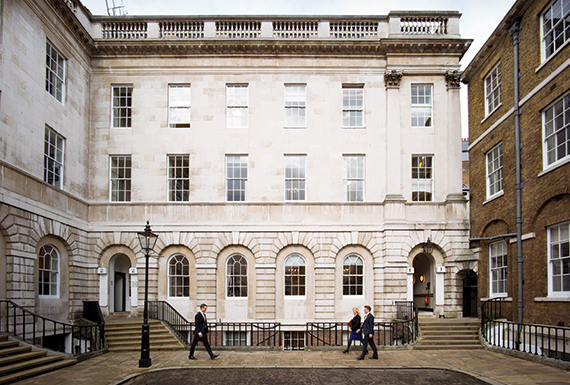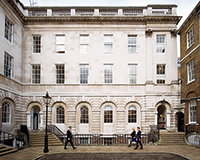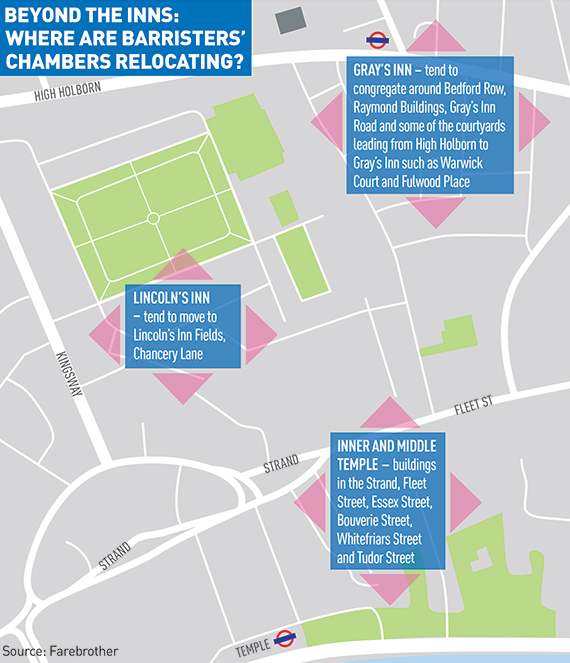 An 11,000 sq ft letting at just over £70 per sq ft in Lincoln’s Inn, WC2, might not sound like a big deal.
An 11,000 sq ft letting at just over £70 per sq ft in Lincoln’s Inn, WC2, might not sound like a big deal.
But law firm Edwin Coe’s expansion into No 11 Stone Buildings signals the increasing commercialisation of the four Inns of Court, which is forcing barristers to consider options beyond the red-brick walls of their spiritual home.
This, and the warning from insurance market Lloyd’s this week that it may move operations to Europe unless Brexit negotiations are favourable, show that old geographical certainties may no longer apply.
Edwin Coe’s 10-year lease on the space, previously occupied by the now dissolved chambers 11 Stone Buildings, represents a record open-market rent. Higher rents in the low £70s have recently been achieved elsewhere at the inns from rent reviews and lease renewals, according to Michael Pain at Carter Jonas, which represented Edwin Coe. On nearby Lower Chancery Lane, new space can be acquired for £60-£65.
John Treacy, executive director at Wilberforce Chambers, which has 60-70 barristers spread across several sites at the inn, said some chambers have begun to appoint advisers for the first time to negotiate with the inn and show they are considering other locations.
He said: “There has been in the last five years a more commercial approach in the inn to the way they operate and that has not gone down well with everybody, because the historical basis of the landlord and tenant relationship in the inns has always been a fairly benevolent and friendly one.”
Barristers’ chambers that have chosen to locate outside of the inn have remained in walking distance of the Royal Courts of Justice. Number 39 Essex Chambers took 50,000 sq ft at Deerbrook Group’s 81 Chancery Lane in February last year.
Alistair Subba Row, senior partner at Farebrother, said: “By volume, it tends to be the bigger sets of chambers that have moved out of the traditional comfort of the short-term leases and lease breaks. The rising rents just don’t make it viable to be inside the Inns of Court for some sets of chambers.”
However, the flexibility, history and brand power associated with an address at the inn means space continues to be in high demand.
Nick Giles, managing partner at Edwin Coe, said: “It is one of our differentiating factors from our competitors who might be happier in a steel and glass block somewhere else in Holborn.”
The quirks of rental valuations at the inn [see box] means chambers benefit from numerous discounts. Treacy said: “While the headline figures can seem very high, when you take into account the fact they measure on a net internal area basis, in our experience it is actually nowhere near that sort of headline level.”
He thinks lack of space is likely to be the biggest driver of any future relocations.
“Financial considerations are not what have been the main driver for us in the past when considering our accommodation requirements; it has more been a case of us not having been able to achieve our key aim of identifying a single building which can house all of our members and staff, in good-quality space, while allowing us to offer the required level of modern and flexible client facilities.”
How do the four inns work?
The Honourable Societies of Lincoln’s Inn, Gray’s Inn, Middle Temple and Inner Temple are voluntary societies that hold the power to invite aspiring barristers to the bar.
Established in the Middle Ages, by the early 17th century the inns had acquired ownership of their sites and began building ornate halls. An estate regeneration programme at Lincoln’s Inn, which began in July, will include major works to the Great Hall, Library and Eastern Terrace.
Rents at the inn are calculated on a net internal area basis, so occupiers are not charged for communal areas such as corridors and lifts. A room overlooking the square will command higher rents than a room with a view of the street. Significant discounts can be applied to higher floors in buildings that do not have a lift.
• To send feedback, e-mail louisa.clarence-smith@estatesgazette.com or tweet @LouisaClarence or @estatesgazette












